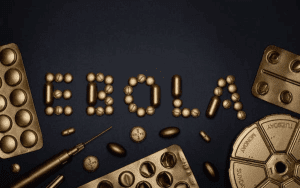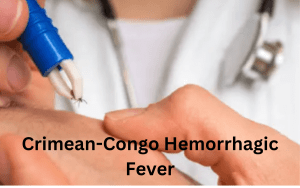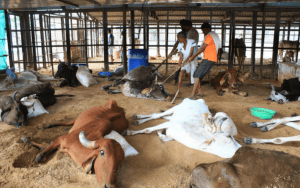Ebola\Congo Virus: Crimean-Congo Hemorrhagic Fever Symptoms and Treatment

In the Crimean-Congo Hemorrhagic fever region is transmitted by ticks and can be fatalIt’s essential to be aware that coming into contact with tick bites or infected animal blood/tissues during or after slaughter are the most common ways that CCHF can be transmitted to humans.
The genus Hyalomma of Ixodid (hard) ticks is a potential reservoir and vector for the CCHF virus.
Patients are primarily farmers, abattoir workers, and veterinarians in the livestock industry. Leukopenia and thrombocytopenia are frequent test findings in individuals with CCHF. With a mortality rate between 40 to 60 percent, it is one of the worst arboviral diseases in the world.
Crimean-Congo Hemorrhagic Fever
Humans can get CCHF from tick bites or by handling contaminated animal blood or tissues just before, during, or after slaughter. Most reported instances have been found in those who deal directly with cattle, including farmers, butchers, and veterinarians.
Close contact with the blood, saliva, organs, or other body fluids of an infected individual can result in transfer to another person. The reuse of needles and contamination of medical supplies are two more common causes of hospital-acquired illnesses.
The duration of the incubation period is contingent upon the specific mode of viral acquisition, exhibiting a range of 1 to a maximum of 13 days. The quick onset of symptoms includes fever, muscle discomfort, disorientation, neck pain and stiffness, backache, headache, painful eyes, and light sensitivity.
Initially, you could have symptoms including nausea, vomiting, diarrhea, stomach discomfort, and a sore throat. After two to four days, agitation may give way to tiredness, despondency, and lassitude, and the stomach discomfort may shift to the upper right quadrant, with the enlarged liver becoming more apparent.
Treatment of symptoms, as well as general supportive care, is the mainstay of CCHF management in humans. Antiviral medication ribavirin has shown promising results in treating CCHF infection. The oral and intravenous forms both show promise.
Those who work in agriculture or with animals should protect any exposed skin and clothes with an insect repellent. The most efficient tick repellents contain DEET (N, N-diethyl-m-toluamide).
Causes\ How Does Crimean-Congo Haemorrhagic Fever Spread?


According to the (WHO), the Crimean-Congo hemorrhagic fever Viral transmission may occur through tick bites or contact with infected animals or byproducts. Handle potentially infected animals with extreme caution and follow safety protocols to avoid serious consequences… Let’s stay informed and take precautions to stay safe.
- Ixodid ticks are reservoirs and transmitters of the Crimean-Congo hemorrhagic fever virus.
- Those who work in agriculture, veterinary medicine, and the meat industry are at a higher risk of contracting an illness.
- Human-to-human transmission can occur by direct contact with contaminated blood, organs, secretions, or other body fluids.
- The transmission of the virus is facilitated through direct contact with bodily fluids that have been contaminated. It is important to note that the virus has been observed to spread exclusively through this transmission mode. Therefore, it is imperative to exercise caution when dealing with potentially infected individuals or materials.
- Use personal protective equipment as a precaution and proper sanitation protocols follow these guidelines to reduce transmission risk.
- Crimean-Congo hemorrhagic fever hotspots can be found in healthcare facilities that fail to adequately disinfect medical equipment and reuse injection needles after treating patients infected with the disease.
Contamination with tick body contents (as when you squish a tick between your fingers), transmission of disease from a tick bite
contact with contaminated human or animal bodily fluids, including blood and tissue.
Risk Factors
Most occurrences are found in people who work with animals and live in tick-infested areas.
- farmers and vets
- Those who operate in abattoirs
- farmers and others involved with animal care
- Caretakers of sick patients, whether medical professionals or others, to minimize the risk of contracting the disease, it is essential to take appropriate measures to prevent the spread of germs.
- Conflict, human and animal migrations, and shifts in climate and vegetation that increase ground cover for small animals that serve as tick hosts are all factors linked to the resurgence of CCHF.
- Tick populations can explode under these circumstances, allowing for more tick-to-human contact.
Symptoms of Crimean-Congo Hemorrhagic Fever?


The incubation time for a virus depends on how it was contracted. Symptoms of a tick bite infection might take three to nine days to show up. The incubation time for illness following exposure to contaminated blood or tissues is typically 5–6 days, with a maximum of 13 days.
Those infected with Crimean-Congo hemorrhagic fever may experience many symptoms,
- including high body temperature,
- weakness,
- disorientation,
- headache,
- stiffness,
- sensitivity to light,
- And pain in the joints and muscles.
- Abdominal discomfort,
- vomiting,
- nausea,
- diarrhea,
- a sore throat,
- disorientation,
- And extreme mood changes are some of the other symptoms.
- Two to four days following the beginning of symptoms,
- The agitation may be replaced by tiredness and sadness.
- The individual is currently reporting a sensation of discomfort or pain in the upper right quadrant of their abdomen.
- Hepatomegaly, or enlarged liver, is another possible side effect.
- Red eyes,
- a sore throat,
- a flushed face,
- And petechiae (or red spots) on the palate are all possible symptoms of Crimean-Congo hemorrhagic fever, as reported by the (CDC). The viral illness may also cause jaundice in the patient.
As the disease advances,
- noticeable bruises appear over large parts of the body,
- injection sites bleed uncontrollably,
- and nosebleeds are frequent.
- These signs and symptoms may appear on day four of sickness and linger for up to two weeks.
- Hospitalized individuals with Crimean-Congo hemorrhagic fever have seen mortality rates as high as 50%.
Other clinical indicators include
- a rapid heart rate (tachycardia),
- a rash characterized by pinpoint red spots (petechial rash),
- And lymphadenopathy (enlarged lymph nodes).
- The petechial rashes can show up anywhere,
- Including the skin and the mucosal surfaces of the mouth and throat. Ecchymoses, which are more extensive rashes, may develop from petechiae when the infection worsens. Then, different forms of hemorrhaging may occur.
After the Fifth Day of sickness,
- critically unwell individuals may experience rapid renal deterioration, lung failure,
- or abrupt liver failure.
According to the World Health Organisation, death from Crimean-Congo hemorrhagic fever often occurs within the second week of symptoms. Most patients who fully recover report feeling better around the ninth or tenth day after their sickness began. The illness has a long incubation period.
Diagnosis and Treatment


- Several laboratory procedures,
- including serum neutralization,
- antigen detection,
- To find out if someone has Crimean-Congo hemorrhagic fever, doctors can use a test called reverse transcriptase polymerase chain reaction (RT-PCR).
- Enzyme-linked immunosorbent assay (ELISA) is a test for detecting antibodies to the virus, namely immunoglobulins G and M.
- Clinical history consistent with Crimean-Congo hemorrhagic fever can be utilized with ELISA antigen capture detection of the viral antigen,
- RT-PCR detection of the viral RNA sequence in the blood,
- And virus isolation to confirm the diagnosis.
Later in the disease,
- Antibodies can be detected in survivors’ blood. Still, the virus, antigen, and viral DNA are not.
- A detectable antibody response is not detected in individuals in the initial few days of the illness or in patients with terminal sickness.
- Thus, viral or RNA detection in tissue or blood samples should be used for diagnosis.
Because patient samples offer such a high biohazard risk, testing them should only be done in the strictest biological containment facilities if a patient is suspected of having the illness. The samples can be manipulated in an essential biosafety environment if they have been inactivated using heat, formaldehyde, or gamma rays.
Treatment
Human Crimean-Congo hemorrhagic fever treatment centres on providing general supportive care. Crimean-Congo hemorrhagic fever patients should maintain proper hydration and electrolyte balances in their bodies. They need to make sure the patient is getting enough oxygen and that any subsequent illnesses are adequately treated.
The antiviral medication ribavirin can be given orally or intravenously to people afflicted with the illness.
What Method Do You Use to Cure Congo Fever?


The primary method used to treat or cure Congo fever is the management of its symptoms. The medicine ribavirin is the first line of defence against Congo fever. This medicine can be taken orally or injected. Patients are not advised to use any other medications. Preventative measures are the sole alternative to treating Congo fever.
Sharp injuries during clinical procedures increase the risk of infection transmission to healthcare personnel. In the past, surgeons have been unknowingly exposed to patients’ infectious diseases while investigating the source of mysterious stomach pain.
For the following 14 days after exposure, healthcare professionals who have come into contact with tissue or blood from patients with suspected or proven CCHF should be isolated, have their temperature checked daily and be monitored for symptoms.
Is there Protection Against CCHF?
Unfortunately, there is currently no CCHF vaccination that can be used safely in humans or animals. Awareness of risk factors and education on steps individuals may take to prevent exposure to the virus are the only ways to lessen the illness.
Are There Any Adverse Effects?
The medicine ribavirin is the standard of care for treating this illness. It’s generally safe, yet it could make some individuals sick. The drug’s usual adverse effects include things like headaches, muscular discomfort, weight loss, nausea, and vomiting.
Although drug-related severe adverse events are highly unusual, they can and do occur. The medicine may cause a variety of side effects, including those related to breathing, bruising, bleeding, dark urine, eyesight, and mental/personality disorders. Because of the potential for harm to the baby, the medicine is also not suggested for nursing moms.
Where Can I Get Information on Aftercare?
The incubation period for Congo fever is typically two weeks. The patient’s chances of survival increase after they show signs of improvement. However, over 40% of those who get the disease die within the first two weeks. When recovering from illness, it’s essential to focus on getting enough rest and eating well.
When will I Feel Better?
Although the likelihood of deterioration in health beyond the first two weeks is pretty low, recovery is gradual. You should keep taking the medicine until your doctor tells you to stop. On the ninth or tenth day, if the patient shows signs of improvement, it may be a good sign that they will fully recover.
Death Toll From Congo Fever:
The WHO estimates that the death rate from Congo fever is between 10% and 40%. Since the mortality rate is significant and most fatalities occur in the second week of infection, doctors need to watch patients intensively during this period.
Do the Treatment’s Effects Last Forever?
In most cases, the treatment’s effects will last a lifetime. However, the illness may return if the medication is discontinued too soon. If the prescribed therapy is completed, however, the likelihood of the condition returning is minimal.
Can Congo’s Disease be Treated?
Congo fever treatment focuses primarily on alleviating symptoms. Fluid and electrolyte balance, oxygenation, hemodynamic support, and treatment of secondary infections should all be given particular attention.
Prevention


Crimean-Congo hemorrhagic fever epidemics can be averted by animal and tick management, infection prevention in healthcare facilities, and individual risk mitigation.
Livestock production facilities can be managed to reduce the transmission of the virus that causes Crimean-Congo hemorrhagic fever by employing acaricides, which are drugs designed to kill ticks. There is currently a lack of animal vaccinations.
There is presently no safe and effective vaccination generally accessible for human use against CCHF, despite the development and limited use of an inactivated vaccine produced from the mouse brain in Eastern Europe.
Without a vaccine, the only method to lessen the spread of infection among humans is to make them more cognizant of the dangers they face and aware of the preventative steps they may take.
- Wearing light colours helps identify ticks on clothing,
- using approved repellents on the skin,
- getting rid of tick infestations on animals,
- applying approved acaricides to dress,
- Performing regular tick checks helps lower the risk of transmitting tick-borne diseases from humans to humans.
- Wearing gloves and other protective clothes when working with animals can help prevent spreading diseases like Crimean-Congo hemorrhagic fever.
- Avoiding direct physical contact with persons sick with Crimean-Congo hemorrhagic fever,
- Washing hands routinely after caring for unwell people and wearing protective equipment when caring for infected patients are all ways to lessen the spread of the illness from person to person.
- The public needs to know what they can do to protect themselves from contracting Crimean-Congo hemorrhagic fever. The risk factors for the disease need to be made more widely known.
- Follow infection control procedures to prevent the spreading of infections in healthcare facilities.
- Personal protective equipment, hand washing, proper burial procedures, and injection techniques are all part of the measures to take.
- Clinicians treating patients with suspected or confirmed Crimean-Congo hemorrhagic fever should practise infection control by World Health Organisation (WHO) guidelines established for Ebola and Marburg hemorrhagic fever.
- DEET (N, N-diethyl-m-toluamide) containing insect repellents are recommended by the CDC for use against ticks.
- Agricultural workers and animal handlers must wear protective clothing to prevent bodily fluid contact.
According to the CDC, a small-scale trial of an inactivated vaccine produced from mouse brains against Crimean-Congo hemorrhagic fever has been conducted in Eastern Europe.
While ribavirin and other antiviral medications have shown some promise in treating hepatitis C, no safe and effective vaccine is available for human use. More study is needed to create possible vaccines and assess the efficacy of treatment alternatives.
Prevention of Human-Animal Transmission:


- When slaughtering, butchering, or culling animals, either professionally or at home, in endemic regions, it is essential to use gloves and other forms of personal protection equipment;
- It is common practice to either quarantine animals for two weeks before slaughter or to routinely treat animals with insecticides.
- Community-wide efforts to lower the likelihood of spread among people:
- Use precautions such as gloves and masks while dealing with patients;
- Always wash your hands after touching a sick person or handling their care.
Reducing the Spread of Infections in Healthcare Facilities
Standard infection control practices should be followed by healthcare providers while treating patients with suspected or confirmed CCHF or when handling specimens from these patients. Safe injection procedures, proper body positioning for burial, and basic hand hygiene are all examples of this.
- Medical personnel treating patients just outside the CCHF epidemic zone should also take regular precautions to prevent the spread of the disease.
- Patients suspected of having CCHF should only have their samples processed in laboratories with the appropriate personnel and equipment.
- Infection control guidelines for treating patients suspected of having or proven to have Crimean-Congo hemorrhagic fever should mirror those established by the World Health Organisation (WHO) for Ebola and Marburg hemorrhagic fever.
Distinctions Among Malaria, Dengue Fever, Chikungunya, and the Congo Virus
Any viruses or parasites that may be present in the blood are ingested by the mosquito along with the blood itself. The mosquito’s saliva can spread these pathogens to the next person it bites. We call any illness that may be transmitted from an infected mosquito to a human (or animal) a “mosquito-borne disease.”
The mosquito itself may not feel any ill effects, but the human victims of these illnesses might suffer greatly. Each year, deadly diseases spread by mosquitoes kill more than 700 million people worldwide.
Let’s examine many of these illnesses in depth.
Dengue
Dengue fever is the most severe illness spread by mosquitoes, according to the World Health Organisation (WHO). Between 100 and 400 million new cases are reported each year, making it the fastest-spreading infectious disease of the last several decades.
The Aedes is the primary carrier of the dengue virus, also known as dengue fever. This mosquito species mainly lives in tropical regions and is responsible for spreading the disease. They are active during the day, typically from dawn to dusk, and bite humans during this time.
High fever, headaches, vomiting, joint discomfort, and rashes are common symptoms, and they can last anywhere from two to seven days.
Malaria
Nearly half of the world’s population faced malaria risk in 2019, per the World Health Organisation (WHO). In that year, there were an estimated 229 million instances of illness, resulting in 409,000 deaths.
The spread of malaria in humans can be attributed to the bite of the female Anopheles mosquito. It is noteworthy that the transmission of this disease occurs solely through the vector above. Hence, effective control measures must be put in place to curb the spread of malaria.
Malaria can cause symptoms including fever, headache, and chills that aren’t always obvious at first. Ten to fifteen days after an infected bite, these symptoms may occur.
Chikungunya
It is imperative to note that the Chikungunya virus is only transmissible to humans through mosquito bites. Therefore, it is crucial to take necessary precautions to prevent mosquito bites and stay protected against this virus.
By doing so, you can enjoy a worry-free day without any health concerns. Even while it’s not often deadly, the joint pain it causes can be excruciating.
The word ‘chikungunya’ originates from the Kimakonde language. The crippling agony in the affected joints is the root of the word’s meaning since the condition forces its victims to stoop.
These mosquitoes are daytime biters, often active between dawn and dusk.
Fever, muscle and joint discomfort, a rash, a headache, or extreme exhaustion might be signs.
As with dengue, chikungunya can produce high fever and painful joint pain, and since it has similar clinical indications to dengue, it is commonly misdiagnosed in regions where both infections are common. Although symptoms often subside after a week, joint discomfort can occasionally persist for several months.
Zaire Virus\ Congo virus
The tick-borne virus known as Congo virus or Crimean-Congo hemorrhagic fever (CCHF) affects both wild and domestic animals, including cattle.
Ticks and infected animals/meat can transmit diseases to humans. Human-to-human communication is also conceivable in case of close contact with the organs, blood or other secretions and body fluids of the infected individual.
With a high case fatality ratio (between 10% and 40%), this virus poses a risk to public health services and might even cause outbreaks.
Headache, high temperature, back discomfort, joint pain, stomach pain, and vomiting are the first signs. Petechiae (little red patches) on the palate, red eyes, and reddened cheeks and neck are all symptoms. Jaundice is another possible symptom, as are mood and sensory perception shifts in more extreme instances.
FAQs
What causes the Congo virus?
The Nairovirus, a member of the Bunyaviridae family, is responsible for spreading Crimean-Congo hemorrhagic fever (CCHF), a devastating illness. Case mortality rates range from 10% to 40% during outbreaks of severe viral hemorrhagic fever caused by the CCHF virus.
The Congo virus: what occurs there?
Hemorrhagic fever in the Crimean-Congo region is caused by a virus. Fevers, muscular pains, headaches, vomiting, diarrhea, and external bleeding are all possible symptoms of CCHF. Less than two weeks usually pass between exposure and the onset of symptoms. One possible complication is a hepatic failure.
What other problems might the Congo virus cause?
After the fifth day of sickness, hepatitis is frequently present, and individuals in the severe illness category may undergo fast renal deterioration, abrupt liver failure, or pulmonary failure. The primary method for managing Crimean-Congo hemorrhagic fever (CCHF) in humans.
How does the Congo virus replicate?
Ticks, vertebrates, and more ticks are responsible for perpetuating the CCHF virus. Small animals are thought to be the primary hosts of zoonotic organisms. However, cattle can act as secondary hosts. Only humans show apparent symptoms of illness.
What is the alternate term for the Congo virus?
Ticks can transmit a virus from the Bunyaviridae family, which can lead to the dangerous and potentially life-threatening Crimean-Congo hemorrhagic fever. Protect yourself from this tick-borne disease by taking preventative measures and seeking medical attention if you experience symptoms. (CCHF). Crimean hemorrhagic fever is the term given to this condition after it was first identified in 1944.
Where does the Congo virus often infect?
CCHFV’s primary reservoir hosts are hares and hedgehogs, whereas cattle, sheep, goats, horses, swine, and birds serve as intermediate hosts. We humans just happen to be the hosts.
To treat Congo fever, what do you recommend?
Again, ribavirin is the medicine of choice for post-exposure prophylaxis, and it is indicated for usage in situations of high-risk exposure.
Which animal is infected with the Congo virus?
The link between CCHFV and animals and humans is complex. Despite widespread CCHFV infection in both wild and domestic mammalian populations, including bovines and ovines, as well as some avian species like ostriches, the virus seldom results in life-threatening illness.
Can you tell me the name of the virus responsible for Congo fever?
CCHF is a tick-borne viral illness found across Africa, Asia, Europe, and the Middle East. It belongs to the Nairovirus genus and causes hemorrhagic fever.
Congo virus: DNA or RNA?
Crimean-Congo hemorrhagic fever (CCHF) is a severe hemorrhagic disease transmitted by ticks and widespread in Africa, Europe, and Asia. , genus Nairovirus, and subfamily ssRNA, negative sense.
Click blogkingworld.com for more health awe-inspiring articles.




